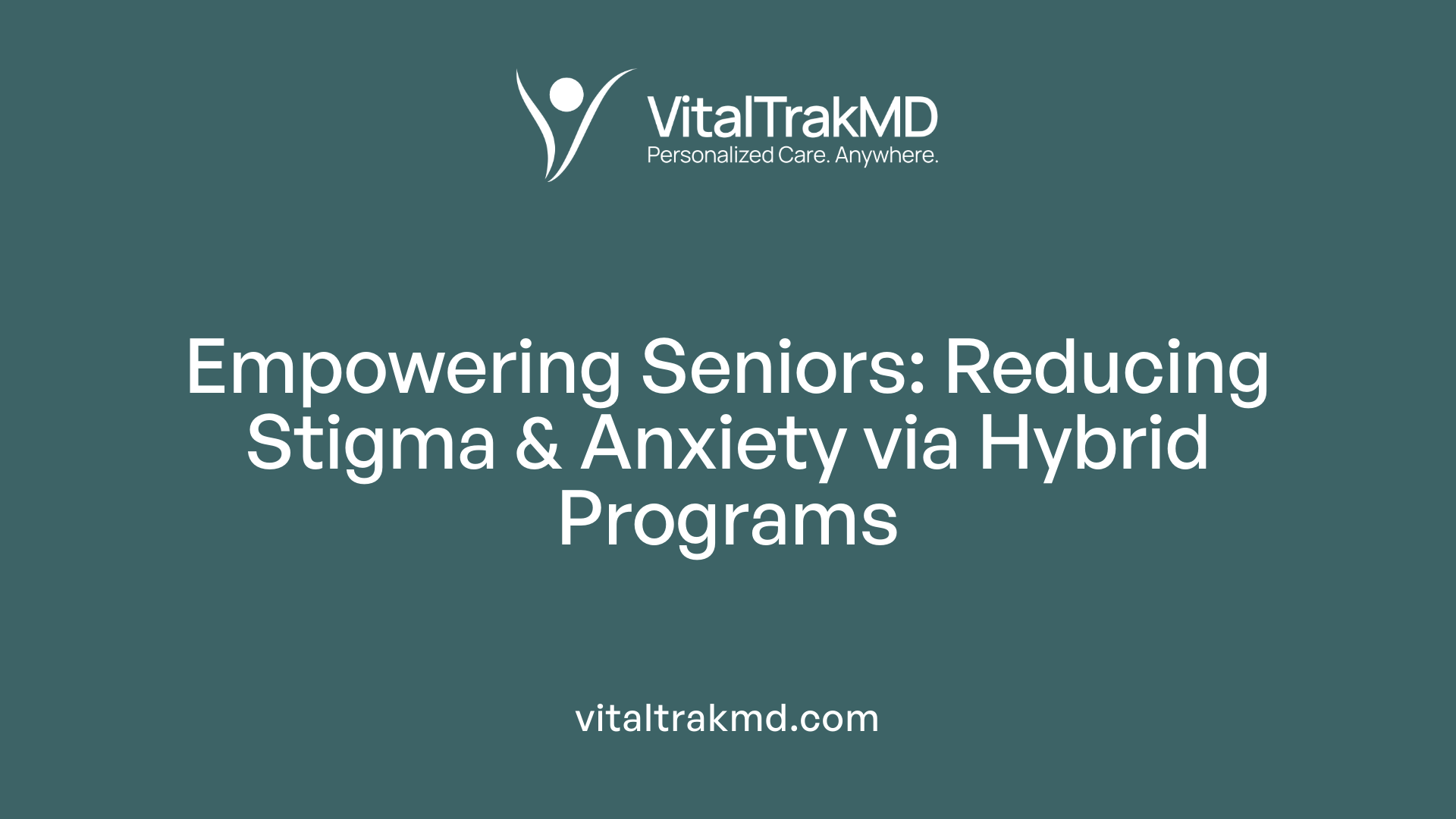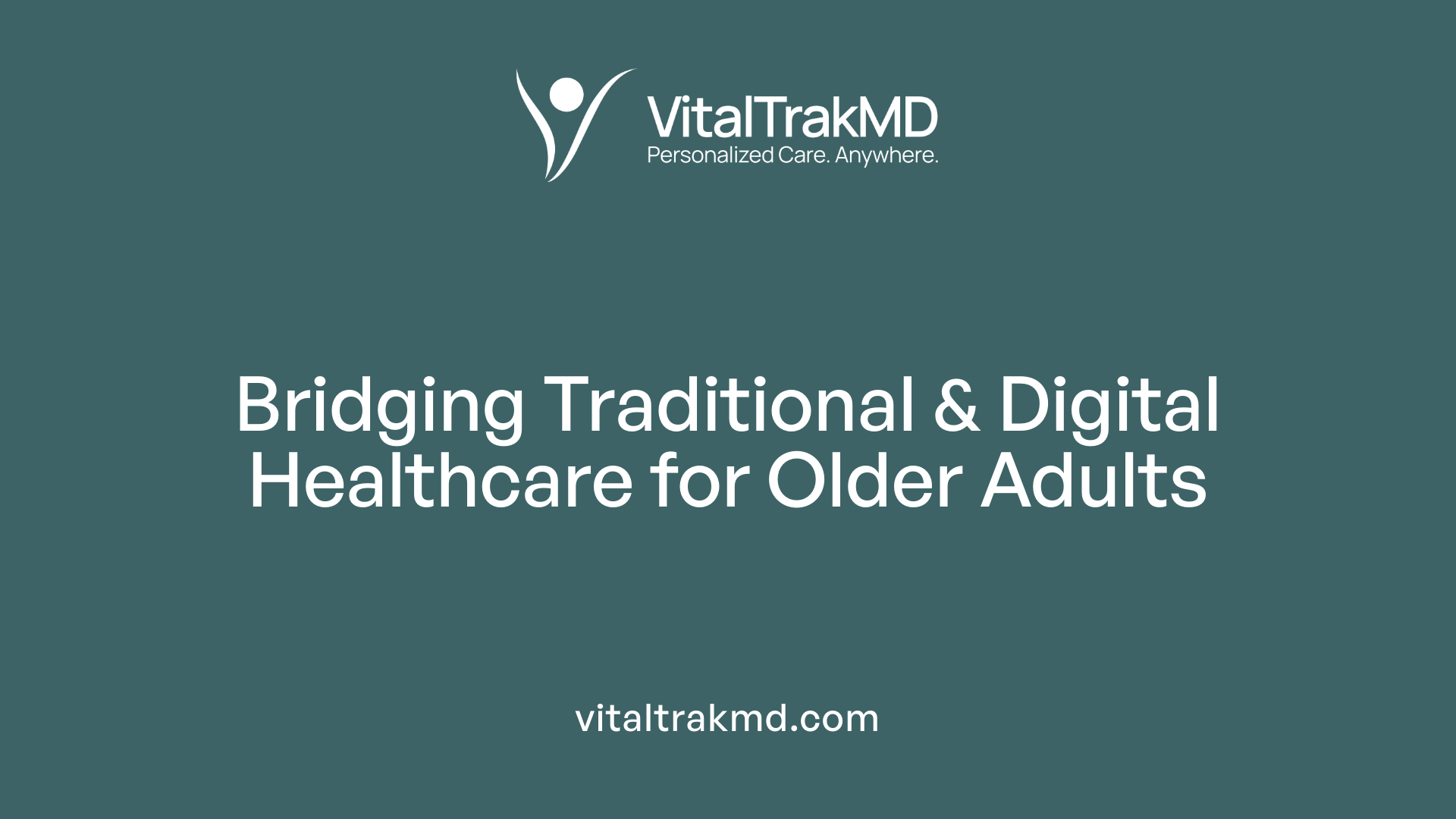Why Hybrid Programs Help Seniors Overcome Healthcare Anxiety

Understanding the Growing Need for Flexible Healthcare Solutions for Seniors
As the global population ages, healthcare providers face increasing challenges in delivering accessible, effective, and personalized care to seniors. Traditional models often fall short in addressing their unique needs, particularly in mitigating healthcare-related anxiety. Hybrid healthcare programs, which blend in-person and virtual services, are emerging as a promising solution, offering seniors the flexibility, accessibility, and tailored support necessary for improved mental and physical well-being.
The Effectiveness of Hybrid Psychoeducation for Older Adults

How does hybrid psychoeducation impact depression literacy, stigma, and anxiety among seniors?
Hybrid-delivered community psychoeducation programs have shown promising results in improving mental health awareness among older adults. These programs include both in-person and online components, making them accessible and adaptable. Participants in these programs have demonstrated significant gains in understanding depression, reducing stigma, and enhancing their sense of meaning in life.
Furthermore, these interventions contribute to better social support networks and decreased anxiety levels. By increasing mental health literacy and normalizing discussions around mental health, seniors feel more empowered to seek help and support each other. This balanced approach ensures that older adults are not only better informed but also feel less isolated or ashamed of their mental health challenges.
With tailored delivery modes, these psychoeducational efforts effectively address the unique needs of this population, fostering resilience and emotional well-being.
Implementation of MHFA and depression training in hybrid formats
The study incorporated 12-hour Older Person Mental Health First Aid (MHFA) courses and 3-hour late-life depression training, delivered through hybrid formats. This combination involved face-to-face sessions complemented by online modules or virtual meetings. The training modules aimed to improve participants’ ability to identify, understand, and respond to mental health crises and depression symptoms.
Using the hybrid model ensures that educational content reaches a broad audience, even during pandemic-related restrictions. The TORCH principles—Technology provision, On-site technical support, Rehearsal, Connection with group members, Hardcopy notes—were applied to maximize engagement and comprehension, especially for older adults unfamiliar with digital tools.
Both modes of learning facilitated similar improvements in depression literacy and stigma reduction, demonstrating the adaptability and effectiveness of these hybrid training programs.
Participants' improvements and outcomes
Participants across both in-person and hybrid psychoeducational groups experienced notable improvements in their mental health metrics. The data revealed enhanced depression literacy, a decrease in stigma associated with mental health issues, and increased feelings of connectedness and social support.
Additionally, participants reported a greater sense of meaning in life and felt more equipped to manage symptoms of anxiety and depression. Importantly, there were no significant differences in outcomes between the two delivery formats, validating the hybrid approach as a sustainable alternative.
These findings suggest that hybrid community psychoeducation can be an effective tool for fostering resilience and improving mental health among older populations, especially when in-person meetings are limited or impossible.
| Aspect | Details | Additional Notes |
|---|---|---|
| Duration | 12-hour MHFA, 3-hour depression training | Focused on mental health crisis response and late-life depression |
| Delivery Modes | In-person and hybrid | Adaptable to pandemic restrictions or individual needs |
| Participant Gains | Mental health literacy, reduced stigma, social support | No significant difference between modes |
| Principles Used | TORCH | Technology, On-site support, Rehearsal, Connection, Hardcopy notes |
| Target Outcomes | Improved mental health, social connection | Emphasizes sustainability and accessibility |
This approach underscores the importance of flexible, accessible mental health education programs that cater to the older demographic, ensuring ongoing support and resilience in diverse circumstances.
Combining In-Person and Virtual Care to Enhance Outcomes

Why are hybrid programs considered a valuable approach to addressing healthcare anxiety in senior populations?
Hybrid healthcare models merge traditional in-person visits with virtual care, creating a flexible and accessible way to support older adults. They leverage technologies like teleconferencing, mobile apps, and remote monitoring to reach seniors who might face obstacles in accessing regular care, such as transportation issues, mobility limitations, or stigma.
The principles of the TORCH framework—Technology provision, On-site technical support, Rehearsal, Connection with group members, and Hardcopy notes—are foundational in helping older adults adapt to online learning and healthcare delivery. These strategies ensure that seniors feel supported and competent in using digital tools.
Moreover, programs like Digital Clinic integrate these principles, emphasizing tailored technical support and interactive learning environments. Evidence shows that such hybrid approaches can produce outcomes comparable to or better than conventional care in reducing anxiety and depression among seniors.
These models also contribute to sustainability by allowing care to be maintained during emergencies like the COVID-19 pandemic, where in-person contact is limited. Overall, hybrid programs combine the best of both worlds to deliver patient-centered, effective, and adaptable mental health care for older adults.
How does hybrid care influence therapeutic relationships and patient engagement?
In hybrid care, the dual modes of interaction—virtual and in person—offer a unique advantage in strengthening therapeutic bonds. Clinicians can build rapport through regular virtual check-ins, which provide convenience and immediacy. When necessary, in-person visits enable more nuanced assessments, including reading nonverbal cues and employing creative methods like art or music therapy.
This flexible structure empowers older adults to choose how they receive support, increasing their comfort and satisfaction. Feeling in control enhances engagement, adherence to treatment, and trust in healthcare providers.
Research indicates that combining these modes fosters stronger relationships, as seniors are more likely to participate actively when their preferences are accommodated. The comfort of engaging from familiar environments, especially during teletherapy, can reduce anxiety and promote openness.
Both in-person and virtual interactions complement each other, creating a balanced approach that maximizes therapeutic effectiveness and ongoing engagement.
What are the challenges in implementing hybrid healthcare for seniors, and how can they be addressed?
Despite its benefits, implementing hybrid healthcare for seniors involves hurdles such as technological requirements, data security concerns, and the digital divide. Not all older adults have access to high-speed internet or are comfortable navigating digital platforms.
To overcome these, programs must include on-site technical support, simplified digital interfaces, and digital literacy training. Partnering with trusted community organizations can build trust and facilitate outreach.
Ensuring equitable access involves providing devices or internet subsidies to underserved populations. Maintaining strong data security protocols protects patient information, fostering confidence in virtual care.
Flexibility in care delivery—offering options for both digital and in-person visits—allows tailoring based on individual readiness, enhancing adoption and sustainability.
How does hybrid healthcare promote continuity of care and better health outcomes for seniors?
Hybrid healthcare ensures continuous engagement through a blend of face-to-face and remote communication, allowing for consistent monitoring of health status. Digital tools like remote monitoring devices and online portals enable early detection of potential issues, leading to prompt interventions.
This ongoing oversight helps prevent complications, reduces hospitalization rates, and improves medication management.
Furthermore, hybrid models facilitate care coordination among providers, including specialists, ensuring comprehensive and integrated support.
Overall, this sustained connection helps address chronic conditions efficiently, fosters adherence to treatment plans, and reduces anxiety stemming from healthcare uncertainties.
What advantages do teletherapy and in-person therapy each offer to seniors?
Teletherapy provides quick and flexible access for seniors, especially beneficial for those with mobility challenges or living in remote areas. The comfort of being in familiar surroundings can also promote openness and candid communication.
In-person therapy, on the other hand, allows clinicians to observe nonverbal cues, establish a controlled environment, and utilize creative approaches like art or music therapy. These can be particularly effective for clients with severe mental health concerns or safety issues.
Both modes, when integrated within a hybrid care model, offer complementary benefits. Teletherapy ensures convenience and regular access, while in-person sessions provide depth and nuanced assessment.
This combination maximizes the therapeutic potential, improves engagement, and addresses the diverse needs of older adults.
How do digital tools within hybrid healthcare improve patient care for seniors?
Digital tools—like telehealth platforms, remote therapeutic monitoring devices, and mobile health applications—empower seniors to actively engage in their health management. They facilitate real-time symptom tracking, medication adherence, and health education, making support available anytime.
These tools help reduce logistical barriers, such as transportation or scheduling conflicts, by offering 24/7 access to resources and support.
Features like online patient portals enhance communication with healthcare providers, fostering transparency and trust. Moreover, virtual triage and motion capture technologies assist clinicians in conducting safer and more accurate assessments while minimizing risks.
Overall, digital tools personalize care, promote self-management, and improve health outcomes for seniors.
What is the role of community engagement and tailored outreach in successful hybrid senior care programs?
Effective community engagement involves partnering with local organizations, faith groups, and cultural leaders to develop outreach strategies that resonate with diverse populations. Tailoring communication and intervention materials to cultural and linguistic contexts nurtures trust and acceptance.
These efforts encourage participation among underserved or reluctant seniors, addressing barriers like stigma, lack of awareness, or mistrust.
Engagement also facilitates recruitment and retention, ensuring ongoing participation and adherence to care plans.
By involving the community, programs can design culturally appropriate services that respect seniors' backgrounds and preferences, leading to higher success rates and better health outcomes.
This collaborative approach enhances the reach and sustainability of hybrid care models, ultimately making mental health and primary care accessible and effective for all seniors.
Harnessing Hybrid Approaches for a Healthier Aging Population
As the evidence mounts, hybrid healthcare models are demonstrating their potential to significantly reduce healthcare anxiety among seniors by making care more accessible, personalized, and engaging. Combining the benefits of in-person interactions with digital innovations, these programs foster stronger therapeutic relationships, improve mental health literacy, and support ongoing management of physical health conditions. Embracing community-based tailored interventions within hybrid frameworks ensures that diverse needs are met, particularly in underserved populations. Moving forward, integrating hybrid approaches into mainstream senior care promises a future where aging populations receive compassionate, effective, and patient-centered care, ultimately fostering healthier, more confident older adults.
References
- Hybrid-delivered community psychoeducation for people ...
- Calmer Life: A Hybrid Effectiveness-implementation Trial ...
- Why Hybrid Is the Future of Mental Health Care
- Hybrid Counseling: Teletherapy & In-Person Therapy
- What Is Hybrid Healthcare? | Tools, Benefits, and Solutions
- a cross-sectional population-based comparative study
- Community-Based Health-Social Partnership Programme (C ...
- What Is Hybrid Healthcare? | Tools, Benefits, and Solutions
- Healthcare's Future Is a Hybrid Model
- Comparing In-Person Only, Telemedicine Only, and Hybrid ...
Recent articles
Want to Feel Better and Live Healthier?
Join hundreds of patients taking control of their health with personalized care that fits their life – not the other way around.
Rated 4.8/5 by 32+ customers







